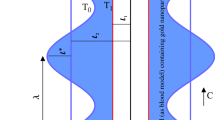Abstract
Gold nanoparticles are more and more used in bio-medical field for their advantages to be employed as contrast medium for diagnostic images and as targets of disease cells in which thermal-therapy or radiotherapy must be applied. In this contest, a suitable concentration of nanoparticles was added to human blood to study in vitro some physical properties of the treated liquid which is prepared to transport the nanoparticles to the different organs where they can be accumulated by metabolic effects. Measurements indicated that the insertion of gold nanoparticles in the human blood improves the blood wetting ability. In particular, the wetting ability of the blood containing or not gold nanoparticles, with respect to different biocompatible solid surfaces, was investigated. Also, the density, tension surface, and viscosity of the solution at room temperature were measured. Results demonstrated that the introduction of gold nanoparticles in the blood, with size distribution centered at about 50 nm, generally improves the wetting ability and changes other properties of the solution, due to the different distributions of the cohesion and adhesion forces.









Similar content being viewed by others
References
Kumar A, Ma H, Zhang X, Huang K, Jin S, Liu J, Wei T, Cao W, Zou G, Liang X-J (2012) Gold nanoparticles functionalized with therapeutic and targeted peptides for cancer treatment. Biomaterials 33(4):1180–1189
Ahmad S, Zamry AA, TinaTan HT, Wong KK, Lim JK, Mohamud R (2017) Targeting dendritic cells through gold nanoparticles: a review on the cellular uptake and subsequent immunological properties. Mol Immunol 91:123–133
Hashmi ASK, Hutchings GJ (2006) Gold catalysis. Angew Chem Int Ed 45:7896–7936
Carrettin S, Carmen Blanco M, Corma A, Hashmi ASK (2006) Heterogeneous gold-catalysed synthesis of phenols. Adv Synth Catal 348:1283–1288
Torrisi L (2015) Radiotherapy improvements by using au nanoparticles. Recent Pat Nanotechnol 9(2):114–125
Lacerda SH, Park JJ, Meuse C, Pristinski D, Becker ML, Karim A, Douglas JF (2010) Interaction of gold nanoparticles with common human blood proteins. ACS Nano 4:365–379
Hussain S, Vanoirbeek JA, Hoet PH (2012) Interactions of nanomaterials with the immune system. Wiley Interdiscip Rev Nanomed Nanobiotechnol 4:169–183
Vogler EA, Siedlecki CA (2009) Contact activation of blood-plasma coagulation. Biomaterials 30:1857–1869
Zhang X-D, Wu H-Y, D. Wu D, Wang YY, Chang J-H, Zhai Z-B, Meng A-M, Liu P-X, Zhang L-A, and Fan F-Y (2010), Toxicologic effects of gold nanoparticles in vivo by different administration routes, Int J Nanomedicine 5, 771
Torrisi L, Scolaro C (2017) Nanoparticles improving the wetting ability of biological liquids. J Thermodin Catal 8(2):1000184
Brass LF (1991) The biochemistry of platelet activation. In: Hoffman R, Benz EJ, Shattil SJ, Furie B, Cohen HJ (eds) Hematology. Basic principles and practice. Churcill Livingstone, New York, pp 1176–1197
Bertrand ME, Legrand V, Boland J, Fleck E, Bonnier J, Emmanuelson H, Vrolix M, Missault L, Chierchia S, Casaccia M, Niccoli L, Oto A, White C, Webb-Peploe M, Van Belle E, MacFadden EP (1998) Randomized multicenter comparison of conventional anticoagulation versus antiplatelet therapyin unplanned and elective coronary stenting. The full anticoagulation versus aspirin and ticlopidine (FANTASTIC) study. Circulation 98:1597
Torrisi L, Restuccia N, Cuzzocrea S, Paterniti I, Ielo I, Pergolizzi S, Cutroneo M, Kovacik L (2017) Laser-produced Au nanoparticles as X-ray contrast agents for diagnostic imaging. Gold Bull 50(1):51–60
Bertina RM, Koeleman BP, Koster T, Rosendaal FR, Dirven RJ, de Ronde H, van der Velden PA, Reitsma PH (1994) Mutation in blood coagulation factor V associated with resistance to activated protein C. Nature 369:64
Clegg C (2013), Contact angle made easy ramé-hart. Book, first edition 40–47, pp. 4–10, ISBN Number 978–1–300-66298-3
Aksay IA, Hoge CE, Pask JA (1974) Wetting under chemical equilibrium and nonequilibrium conditions. J Phys Chem 78:1178–1183
Torrisi L, Scolaro C, Restuccia N (2017) Wetting ability of biological liquids in presence of metallic nanoparticles. J Mater Sci Mater Med 28:63
Murty RC (1965) Effective atomic numbers of heterogeneous materials. Nature 207:398–399
Torrisi L, Scolaro C (2015) Treatment techniques on aluminum to modify the surface wetting properties. Acta Phys Pol A 128(1):48–53
Torrisi L (2017) Evaluation of the radiotherapy and Protontherapy improvement using gold nanoparticles. Gold Bull 50(4):299–311
Restuccia N, Torrisi L (2018) Nanoparticles in liquids generated laser as contrast medium and radiotherapy intensifiers. EPJ Web Conf 167:04007
Garcia MA (2011) Surface plasmon in metallic nanoparticles: fundamental and applications. J Phys: Appl Phys 44:28
Torrisi L, Restuccia N, Paterniti I (2018) Gold nanoparticles by laser ablation for X-ray imaging and protontherapy improvements. Recent Pat Nanotechnol 12:59
Joanna Lim ZZ, Jasmine Li JE, Teng Ng C, Lanry Yung LY, Huat Bay B (2011) Gold nanoparticles in cancer therapy. Acta Pharmacol Sin 32(8):983
Acknowledgements
Authors thank the collaboration with the Department of Biology and Chemistry of Messina University and with the Dentistry Clinic of Catania University.
Funding
This work was supported by the “Research and Mobility” project of Messina University No. 74893496, scientifically coordinated by Professor L. Torrisi.
Author information
Authors and Affiliations
Corresponding author
Additional information
Publisher’s Note
Springer Nature remains neutral with regard to jurisdictional claims in published maps and institutional affiliations.
Rights and permissions
About this article
Cite this article
Torrisi, L., Scolaro, C. & Restuccia, N. Wetting ability of human blood in the presence of gold nanoparticles. Gold Bull 51, 111–121 (2018). https://doi.org/10.1007/s13404-018-0236-1
Received:
Accepted:
Published:
Issue Date:
DOI: https://doi.org/10.1007/s13404-018-0236-1




